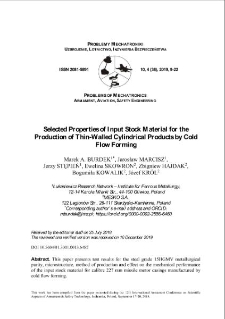Our Digital Library contains 1 868 digital objects
Object
Title: Selected Properties of Input Stock Material for the Production of Thin-Walled Cylindrical Products by Cold Flow Forming
Alternative title:
Contributor:
Jarosław MARCISZ, Jerzy STĘPIEŃ, Ewelina SKOWRON, Zbigniew HAJDAK, Bogumiła KOWALIK, Józef KRÓL
Abstract:
This paper presents test results for the steel grade 15HGMV metallurgical purity, microstructure, method of production and effect on the mechanical performance of the input stock material for calibre 227 mm missile motor casings manufactured by cold flow forming. The reference product for the determination of preliminary design criteria of missile casings of the higher calibre were calibre 122 mm missiles manufactured in Poland. The final mechanical properties of the casings are a cumulative effect of quenching and tempering and strain hardening during cold flow forming. The research and industrial practice carried out so far have demonstrated that the production process of a Feniks missile (with a 1.5 mm thick casing wall) requires steel grades of extremely high purity. This steel grade is manufactured by VAD (Vacuum Arc Degassing) melting, followed by ESR (ElectroSlag Remelting) or, alternatively by melting and casting in vacuum oven. The content of hard and non-deformable non-metallic inclusions such as oxides is critical to the success of cold flow forming. The calibre 227 mm missile casings feature walls approximately 2.5 mm thick and produced by cold flow forming from a quenched and tempered intermediate product. New material specifications should be developed for this reason to enable correct cold flow forming and contribute to a significant improvement in the cost efficiency of manufacturing. The investigations covered herein were guided by an assumption that the thicker wall sections might make the material specifications applicable to lower-calibre missiles to restrictive and obsolete about calibre 227 missiles. After initial laboratory tests, this hypothesis will be verified in industrial experiments on the production of prototype missile casings from input stock materials varying in metallurgical purity.
Place of publishing:
Warszawa
Publisher:
Date created:
Date submitted:
Date accepted:
Date issued:
Extent:
Identifier:
oai:ribes-88.man.poznan.pl:2563
Call number:
Electronic ISSN:
Print ISSN:
Language:
Rights holder:
Starting page:
Ending page:
Volume:
Keywords:
materials engineering, rocket casing, manufacturing
Object collections:
Last modified:
Sep 29, 2025
In our library since:
Sep 29, 2025
Number of object content hits:
0
All available object's versions:
https://ribes-88.man.poznan.pl/publication/2875
Show description in RDF format:
Show description in OAI-PMH format:
| Edition name | Date |
|---|---|
| Selected Properties of Input Stock Material for the Production of Thin-Walled Cylindrical Products by Cold Flow Forming | Sep 29, 2025 |
Objects Similar
Paweł BIAŁOBRZEWSKI Judyta SIENKIEWICZ, Jacek JANISZEWSKI, Janusz KLUCZYŃSKI
Marek BURDEK Jerzy STĘPIEŃ, Wojciech WÓJTOWICZ

